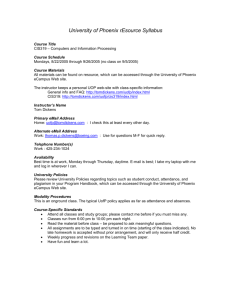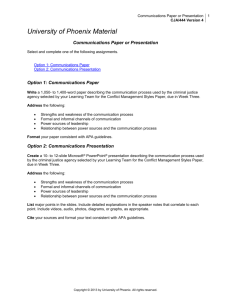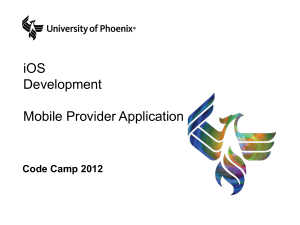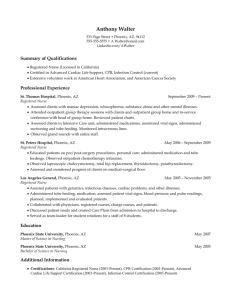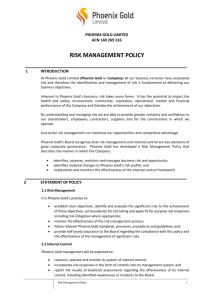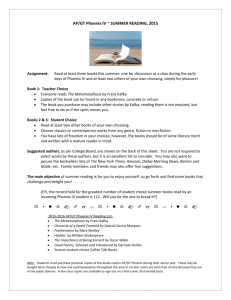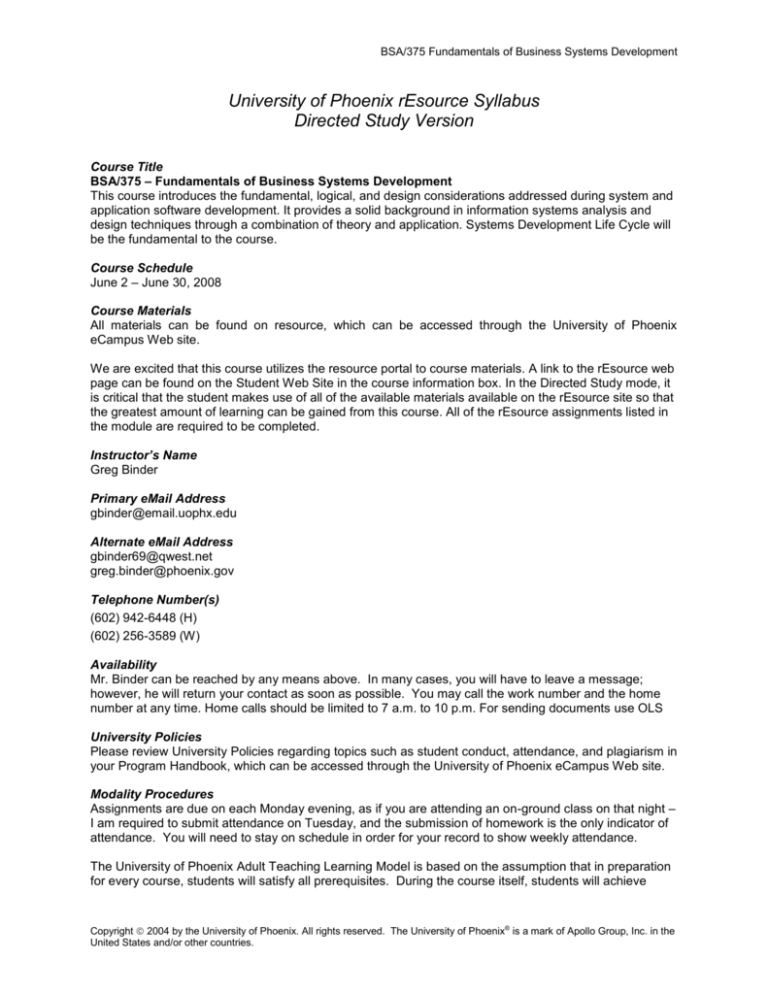
BSA/375 Fundamentals of Business Systems Development
University of Phoenix rEsource Syllabus
Directed Study Version
Course Title
BSA/375 – Fundamentals of Business Systems Development
This course introduces the fundamental, logical, and design considerations addressed during system and
application software development. It provides a solid background in information systems analysis and
design techniques through a combination of theory and application. Systems Development Life Cycle will
be the fundamental to the course.
Course Schedule
June 2 – June 30, 2008
Course Materials
All materials can be found on resource, which can be accessed through the University of Phoenix
eCampus Web site.
We are excited that this course utilizes the resource portal to course materials. A link to the rEsource web
page can be found on the Student Web Site in the course information box. In the Directed Study mode, it
is critical that the student makes use of all of the available materials available on the rEsource site so that
the greatest amount of learning can be gained from this course. All of the rEsource assignments listed in
the module are required to be completed.
Instructor’s Name
Greg Binder
Primary eMail Address
gbinder@email.uophx.edu
Alternate eMail Address
gbinder69@qwest.net
greg.binder@phoenix.gov
Telephone Number(s)
(602) 942-6448 (H)
(602) 256-3589 (W)
Availability
Mr. Binder can be reached by any means above. In many cases, you will have to leave a message;
however, he will return your contact as soon as possible. You may call the work number and the home
number at any time. Home calls should be limited to 7 a.m. to 10 p.m. For sending documents use OLS
University Policies
Please review University Policies regarding topics such as student conduct, attendance, and plagiarism in
your Program Handbook, which can be accessed through the University of Phoenix eCampus Web site.
Modality Procedures
Assignments are due on each Monday evening, as if you are attending an on-ground class on that night –
I am required to submit attendance on Tuesday, and the submission of homework is the only indicator of
attendance. You will need to stay on schedule in order for your record to show weekly attendance.
The University of Phoenix Adult Teaching Learning Model is based on the assumption that in preparation
for every course, students will satisfy all prerequisites. During the course itself, students will achieve
Copyright 2004 by the University of Phoenix. All rights reserved. The University of Phoenix® is a mark of Apollo Group, Inc. in the
United States and/or other countries.
BSA/375 Fundamentals of Business Systems Development
certain learning outcomes. All performance assessment depends upon the accomplishment of these
outcomes. Students are graded on achievement, rather than effort.
All graded assignments must comply with the University of Phoenix Approved Style Guide.
Attendance and Participation
Assignments are due on Monday evening, as if you are attending an on-ground class on that night – I am
required to submit attendance on Tuesday, and the submission of homework is the only indicator of
attendance. You will need to stay on schedule in order for your record to show weekly attendance.
Feedback
I will print out, grade and return your submissions by e-mail. You are welcome to contact me with any
questions in this regard.
Incompletes
If you are unable to complete the coursework you should seek guidance from your academic counselor –
as a matter of University policy, incompletes are not granted.
Course-Specific Standards
The following STANDARDS FOR WRITTEN WORK are promulgated by the University of
Phoenix and should be referred to by the student when submitting written work, and will be used by the
instructor to evaluate that work:
Content/Development
All key elements of the assignment are covered in a substantive way.
Content is comprehensive, accurate, and/or persuasive,
Major points are stated clearly, are supported by specific details, examples, or analysis, and
are organized logically.
Where appropriate, the paper supports major points with theory relevant to development of
the ideas, and uses the vocabulary of the theory correctly.
There is integration of theory and practice whereby the writer is able to link theories to
practical experience (i.e., application to the "real world" work setting).
Research is adequate and timely for the topic.
The context and purpose of the writing is clear( e.g., critique, research, sample memo,
business plan).
Organization
The structure of the paper is clear and easy to follow.
The paper's organization emphasizes the central theme or purpose and is directed toward the
appropriate audience.
Ideas flow in a logical sequence.
The introduction provides sufficient background on the topic and previews major points.
Paragraph transitions are present and logical, and maintain the flow of thought throughout the
paper.
The conclusion is logical and flows from the body of the paper.
The conclusion reviews the major points.
Format
The paper, including citations and the reference page, follows APA guidelines for format.
The paper is laid out effectively and uses reader-friendly aids (e.g., sections, summaries,
tables of contents, indices, appendices) when appropriate.
The paper utilizes references appropriately.
Headings, the use of italics, etc., aid in the readability of the paper and are not "overdone."
The paper is neat, with attention given to format requirements.
Copyright 2004 by the University of Phoenix. All rights reserved. The University of Phoenix® is a mark of Apollo Group, Inc. in the
United States and/or other countries.
BSA/375 Fundamentals of Business Systems Development
Grammar Punctuation/Spelling
Rules of grammar, usage, and punctuation are followed.
Spelling is correct.
Readability/Style
Sentences are complete, clear, and concise.
Sentences are well-constructed, with consistently strong, varied structure.
Sentence transitions are present and maintain the flow of thought.
Words used are precise and unambiguous
The tone is appropriate to the content and assignment.
I will provide you with as much feedback as possible to assist your understanding. If you have further
questions, please feel free to call or e-mail.
Welcome
Welcome to Fundamentals of Business Systems Development ! This document provides a description of
the Directed Study course, as defined by the instructor and the University of Phoenix. Students at many
colleges and universities take such an introductory course. The course introduces the roles, processes,
and disciplines of involved during the Analysis process of information technology solutions to business
problems and opportunities. (I encourage you to use the World Wide Web as a resource throughout the
course. Of course, you know that course materials are available on-line. The student’s understanding of
the material will be evaluated through written products, proved via e-mail. BSA/375 is a foundation
course for continued study in the field of information technology as well as providing an essential
background in IT for practitioners in other fields.
Instructor Bio
Your instructor comes to you with over 33 years of teaching experience. He is a graduate of the US
Military Academy at West Point and holds a Masters Degree in Computer Science from the University of
Arizona. He taught Computer Science at the Academy for three years. Subsequently he served on the
staff of the US Army Management Systems Support Agency at the Pentagon. Since 1980, he has
worked for the City of Phoenix Information Technology Department, consulted for the US Army Pentagon
and the State Department, and taught in the Business College and School of Public Affairs at Arizona
State University. He has been a faculty member with the University of Phoenix since 1983, in all aspects
of graduate and undergraduate information systems subjects. He is involved with both classroom
delivery and Directed Study programs. At the City of Phoenix Mr. Binder has managed development of
the e-commerce program, privacy, the e-government program, and served as project manager for webbased applications. He currently heads the Enterprise Technology Management team, with
responsibilities for enterprise architecture; strategic, technical, and operational technology planning,
disaster recovery planning, and mobile computing strategy development. He is also on the MBA faculty of
Ottawa University.
Academic Honesty
Academic honesty is highly valued at the University of Phoenix. Students must always submit work that
represents their original words or ideas. If any words or ideas used in a class posting or assignment
submission do not represent the student’s original words or ideas, all relevant sources must be cited
along with the extent to which such sources were used. Words or ideas that require citation include, but
are not limited to, all hard copy or electronic publications, whether copyrighted or not, and all verbal or
visual communication when the content of such communication clearly originates from an identifiable
source. Please see the University of Phoenix Catalog for more information about academic honesty,
including consequences of academic dishonesty.
Copyright 2004 by the University of Phoenix. All rights reserved. The University of Phoenix® is a mark of Apollo Group, Inc. in the
United States and/or other countries.
BSA/375 Fundamentals of Business Systems Development
Privacy and Confidentiality in the University of Phoenix Classroom
One of the highlights of the University of Phoenix academic experience is that students can draw on the
wealth of examples from their organizations in class discussions and in their written work. However, it is
imperative that students not share information that is confidential, privileged, or proprietary in nature.
Students must be mindful of any contracts they have agreed to with their companies.
WEIGHTING of ASSIGNMENTS
ASSIGNMENTS
POINTS
Individual
Individual Written Assignment (Week Two)
100
Individual Written Assignment (Week Three)
100
Individual Written Assignment (Week Four)
100
Learning Summaries and Discussion Questions
Paper answering discussion questions (Week One)
40
Paper answering discussion questions (Week Two)
40
Paper answering discussion questions (Week Three)
40
Paper answering discussion questions (Week Four)
40
Paper answering discussion questions (Week Five)
40
Total
500
Point/grade conversion
Grades are calculated as a percentage of the total points %
Grade
%
94+
A
75-76+
91-93+
A72-74+
87-90+
B+
68-71+
83-86+
B
65-67+
80-82+
B<65
77-79+
C+
Grade
C
CD+
D
F
INDIVIDUAL ASSIGNMENTS
Week One
Complete assignments posted on the rEsource course page.
Discussion Question(s):
The discussion questions for week one are related to the articles for week one.
Directed Study students will answer these questions in written form.
Do heuristics and biases play a major role in the success/failure of an IT project? Why or
why not? What specific kinds are the most influential/impact factors – in general and for your
specific organization?
Copyright 2004 by the University of Phoenix. All rights reserved. The University of Phoenix® is a mark of Apollo Group, Inc. in the
United States and/or other countries.
BSA/375 Fundamentals of Business Systems Development
How does organization culture play a role in the successful reliance on the JAD process to
identify/gather business requirements? Would JAD\ work in your company? Why or why
not?
Based on Tallon and Scannell’s (2007) article, describe information life cycle management
(ILM) and the relationship to the cost of storage.
Based on Mitchell’s (2007) article, explain how Musicland stores were converted to the Trans
World Entertainment system in 90 days.
Week Two
Complete assignments posted on the rEsource course page.
Discussion Question(s):
The discussion questions for week one are related to the articles for week one.
Directed Study students will answer these questions in written form.
What is “enterprise-wide analytics technology” and how can it play a part in understand
business processes? What are the challenges in rolling out a Business Intelligence tool?
What are some of the challenges associated with “requirement elicitation”? How does this
iterative approach help that process?
Based on Perkin’s (2007) article, list five reasons why projects fail. Provide an example of a
project failure.
Based on Stotz’s (2007) article, why is it important to adequately define the use of a system?
List five items a typical design document contains.
Individual Assignment:
The final individual paper for this class will be comprised of three sections and due in Week
Four. One section of the paper is due each week.
Complete Section 1 of 3 for the final paper due in Week Four. Using the Service Request SRrm-004, “Analyze HR System,” prepare a 4-6 page paper that accomplishes the following:
Describe the information-gathering techniques and design methods you would
propose to use for the project.
Identify the key factors that will help ensure the information required for the project is
gathered successfully.
Explain the scope and feasibility of the project.
Cite and discuss 3-4 references, in addition to the required readings, that are relevant
to the assignment. Be sure to include citations and references using the University of
Phoenix approved style guide format.
Submit section 1 of the final paper.
Week Three
Complete assignments posted on the rEsource course page.
Discussion Question(s):
The discussion questions for week one are related to the articles for week one.
Directed Study students will answer these questions in written form.
What are the differences between the “human centered” and “user centered” approaches?
Do you agree that that human centered approach is more effective? Why or why not?
Copyright 2004 by the University of Phoenix. All rights reserved. The University of Phoenix® is a mark of Apollo Group, Inc. in the
United States and/or other countries.
BSA/375 Fundamentals of Business Systems Development
Based on Chen’s (2006) article, what general categories do you think a RFP should contain
for a typical software accounting system?
Based on Rajlich’s (2006) article, do you think that the waterfall model is no longer useful in
today’s development environment? Discuss why or why not.
Individual Assignment:
Complete Section 2 of 3 for the final paper due in Week Four. This week’s assignment
incorporates the transition from analysis to design. You may consider revising Section 1
based upon faculty feedback. Prepare a 4-6 page paper that accomplishes the following:
Describe the application architecture and process design.
Apply the tools of systems analysis to describe the information system’s architecture
in terms of data, processes, interfaces and network.
Draw the physical data flow diagram(s). Use Microsoft® Visio® to prepare examples
of flow charts and data flow diagrams.
Cite and discuss 3-4 references, in addition to the required readings, that are relevant
to the assignment. Be sure to include citations and references using the University of
Phoenix approved style guide format.
Submit section 2 of the final paper.
Week Four
Complete assignments posted on the rEsource course page.
Discussion Question(s):
The discussion questions for week one are related to the articles for week one.
Directed Study students will answer these questions in written form.
Is testing a distinct phase of the project, or does it come into play during other phases?
Please explain. How can tools help the quality and effectiveness of testing?
Based on Walsh’s (2007) article, explain why end user satisfaction should be used in addition
to ROI when measuring new systems.
Based on Davidson and Kumagai’s (2008) article, list three advantages and risks associated
with open source software.
Individual Assignment:
Complete Section 3 of 3 for the final paper. This week’s assignment incorporates the
transition from design to implementation. You may consider revising Sections 1 and 2 based
upon faculty feedback. Prepare a 4-6 page paper that accomplishes the following:
Describe the implementation stage for this project.
Include a discussion of the six major activities for the implementation stage as
described within the text: (1) coding, (2) testing, (3) installation, (4) documentation,
(5) training and (6) support. The discussion of these six activities should describe
specifically how each activity would be planned for the individual project situation.
Discuss the benefits of using defined and repeatable processes for accomplishing
these activities for the implementation stage.
Cite and discuss 3-4 references, in addition to the required readings, that are relevant
to the assignment. Be sure to include citations and references using the University of
Phoenix approved style guide format.
Compile Sections 1-3 into one final paper and submit.
Week Five
Complete assignments posted on the rEsource course page.
Copyright 2004 by the University of Phoenix. All rights reserved. The University of Phoenix® is a mark of Apollo Group, Inc. in the
United States and/or other countries.
BSA/375 Fundamentals of Business Systems Development
Discussion Question(s):
The discussion questions for week five are related to the articles for week five.
When does it make sense to outsource – specifically the maintenance and support of an
application system?
How would you rank the six strategies in order of importance? Explain your thinking.
Based on Walsh’s (2007) article, explain why end user satisfaction should be used in addition
to ROI when measuring new systems.
Based on Davidson and Kumagai’s (2008) article, list three advantages and risks associated
with open source software.
According to Dibenedetto’s (2007) article, what are the advantages of on demand software?
Why is maintenance considered an advantage?
Copyright 2004 by the University of Phoenix. All rights reserved. The University of Phoenix® is a mark of Apollo Group, Inc. in the
United States and/or other countries.



